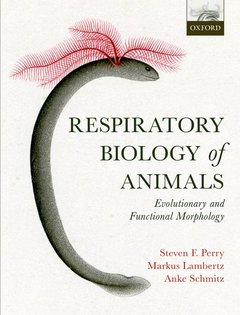Description
Respiratory Biology of Animals
evolutionary and functional morphology
Authors: Perry Steven F., Lambertz Markus, Schmitz Anke
Language: English
Subjects for Respiratory Biology of Animals:
116.54 €
In Print (Delivery period: 21 days).
Add to cart
Respiratory Biology of Animals
Publication date: 10-2019
250 p. · 19.4x25.2 cm · Hardback
Publication date: 10-2019
250 p. · 19.4x25.2 cm · Hardback
59.25 €
In Print (Delivery period: 21 days).
Add to cart
Respiratory Biology of Animals
Publication date: 10-2019
250 p. · 18.9x24.6 cm · Paperback
Publication date: 10-2019
250 p. · 18.9x24.6 cm · Paperback
Description
/li>Biography
/li>
Oxygen uptake for metabolic energy demand and the elimination of the resulting carbon dioxide is one of the essential processes in all higher life forms; in the case of animals, everything from protozoans to insects and vertebrates including humans. Respiratory Biology of Animals provides a contemporary and truly integrative approach to the topic, adopting a strong evolutionary theme. It covers aerobic metabolism at all levels, from gas exchange organs such as skin, gills, and lungs to mitochondria - the site of cellular respiration. The book also describes the functional morphology and physiology of the circulatory system, which often contains gas-carrying pigments and is important for pH regulation in the organism. A final section describes the evolution of animal respiratory systems. Throughout the book, examples are selected from the entire breadth of the animal kingdom, identifying common themes that transcend taxonomy. Respiratory Biology of Animals is an accessible supplementary text suitable for both senior undergraduate and graduate students taking courses in respiratory biology, comparative animal physiology, and environmental physiology. It is also of relevance and use to the many professional academics requiring a concise but authoritative overview of the topic.
Steven Perry completed his Ph.D. in Biology at Boston University, USA in 1975. He undertook postdoctoral research at the Max Planck Institute for Experimental Medicine from 1975-1976 under Johannes Piiper before moving to Bristol University, UK for a year to study the morphometry of fish gills under George M. Hughes. From 1977-1978 he worked at the Justus-Liebig-Universität, Giessen in Germany, on the morphometry of reptilian lungs under Hans-Rainer Duncker. During his career he has held the positions of Assistant and Adjunct Associate Professor of Zoology, Carl-von-Ossietzky-Universität Oldenburg, Germany; Lecurer in Zoology; Adjunct Associate Professor in Anatomy and Cell Biology, University of Calgary, Canada and University Professor for Morphology and Systematics of Animals at the Rheinische Friedrich-Wilhelms-Universität Bonn, whence he retired in 2009. In 2010 he was a CAPES visiting Professor at the Universidade de São Paulo, Ribeirão Preto, Brazil. Markus Lambertz studied biology at the University of Bonn with a major focus on zoology, and minor ones on paleontology and geology. In 2015 he obtained his doctorate under the supervision of Steve Perry with a dissertation on the functional and evolutionary morphology of the amniote respiratory apparatus. Subsequently he became associated postdoc in the herpetological group of the Zoological Research Museum Alexander Koenig in Bonn, and after a short-term stay as a visiting lecturer at the Federal University of Viçosa in Brazil he assumed his current position at the University of Bonn in 2016. His primary research interests encompass the entire breadth of morphology and systematics, particularly that of reptiles. These are supplemented by a keen interest in the history of science. Anke Schmitz did her Diploma thesis and doctoral dissertation at the University of Erlangen, Germany, where she studied respiration in butterflies. During her postdoctoral studies at the Rheinische Friedrich-Wilhelms-Universität Bonn s
© 2024 LAVOISIER S.A.S.




